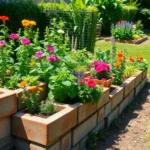We’ve all dreamed of that perfect lawn that makes our neighbors stop and stare in admiration. Whether you’re dealing with a blank slate or looking to transform your current outdoor space, the right grass garden ideas can turn your yard into a stunning industry masterpiece that boosts your home’s curb appeal and value.
From low-maintenance ornamental grasses that sway gracefully in the breeze to creative lawn patterns that define different garden zones, there’s a grass solution for every style preference and climate condition. We’ll explore innovative approaches that combine functionality with visual appeal, helping you create outdoor spaces that require minimal upkeep while delivering maximum impact.
The best part? Many of these grass garden concepts work beautifully for both small urban plots and expansive suburban yards. We’re about to share practical strategies that’ll transform your outdoor space into the envy of the neighborhood while keeping your weekends free from constant yard work.
Create a Classic English Lawn Garden
A traditional English lawn garden represents the pinnacle of refined industry design. We’ll show you how to achieve this timeless aesthetic while maintaining practical functionality for modern homeowners.
Choose the Right Grass Variety for Your Climate
Cool season grasses perform best in northern regions where temperatures rarely exceed 85°F during summer months. Perennial ryegrass creates the quintessential English lawn appearance with its fine texture and emerald green color that thrives in temperatures between 60-75°F.
Fine fescue varieties offer exceptional drought tolerance for homeowners seeking reduced water requirements. These grasses maintain their classic appearance even during dry spells and recover quickly from stress conditions.
Kentucky bluegrass delivers superior density and self repair capabilities that create the uniform carpet effect synonymous with English garden design. This variety spreads through underground rhizomes to fill bare spots naturally.
Warm season alternatives like Zoysia grass work well in southern climates where traditional cool season varieties struggle. Buffalo grass provides similar visual appeal while requiring minimal irrigation in hot, dry regions.
Maintain Proper Mowing Heights and Patterns
Set your mower blade height between 2.5 to 3.5 inches to promote healthy root development and natural disease resistance. Taller grass blades shade the soil surface, reducing weed germination and conserving moisture.
Alternate mowing directions each week to prevent grass from developing a permanent lean and create those coveted striped patterns. Diagonal patterns one week followed by straight lines the next week produce the most dramatic visual effect.
Never remove more than one third of the blade length in a single cutting session to avoid shocking the grass and compromising its health. Weekly mowing during peak growing seasons maintains optimal appearance without stressing the plants.
Sharp mower blades create clean cuts that heal quickly and resist fungal infections common in humid conditions. Dull blades tear grass fibers, leaving brown edges that detract from the pristine English lawn aesthetic.
Incorporate Traditional Border Plantings
Boxwood hedges provide the essential framework for authentic English garden design with their dense evergreen foliage and ability to maintain precise geometric shapes. Plant them 18 inches apart for a solid hedge appearance within three growing seasons.
Lavender borders add fragrance and cottage garden charm while requiring minimal maintenance once established. English lavender varieties like ‘Hidcote’ and ‘Munstead’ create neat, compact borders that complement manicured grass areas.
Rose bushes serve as classic focal points along lawn edges, particularly David Austin varieties that combine old fashioned blooms with modern disease resistance. Plant climbing roses against walls or fences to create vertical interest.
Perennial flower beds filled with delphiniums, foxgloves, and hollyhocks establish the quintessential English garden backdrop. These tall flowering plants create natural privacy screens while adding seasonal color changes throughout the growing year.
Design Ornamental Grass Feature Gardens
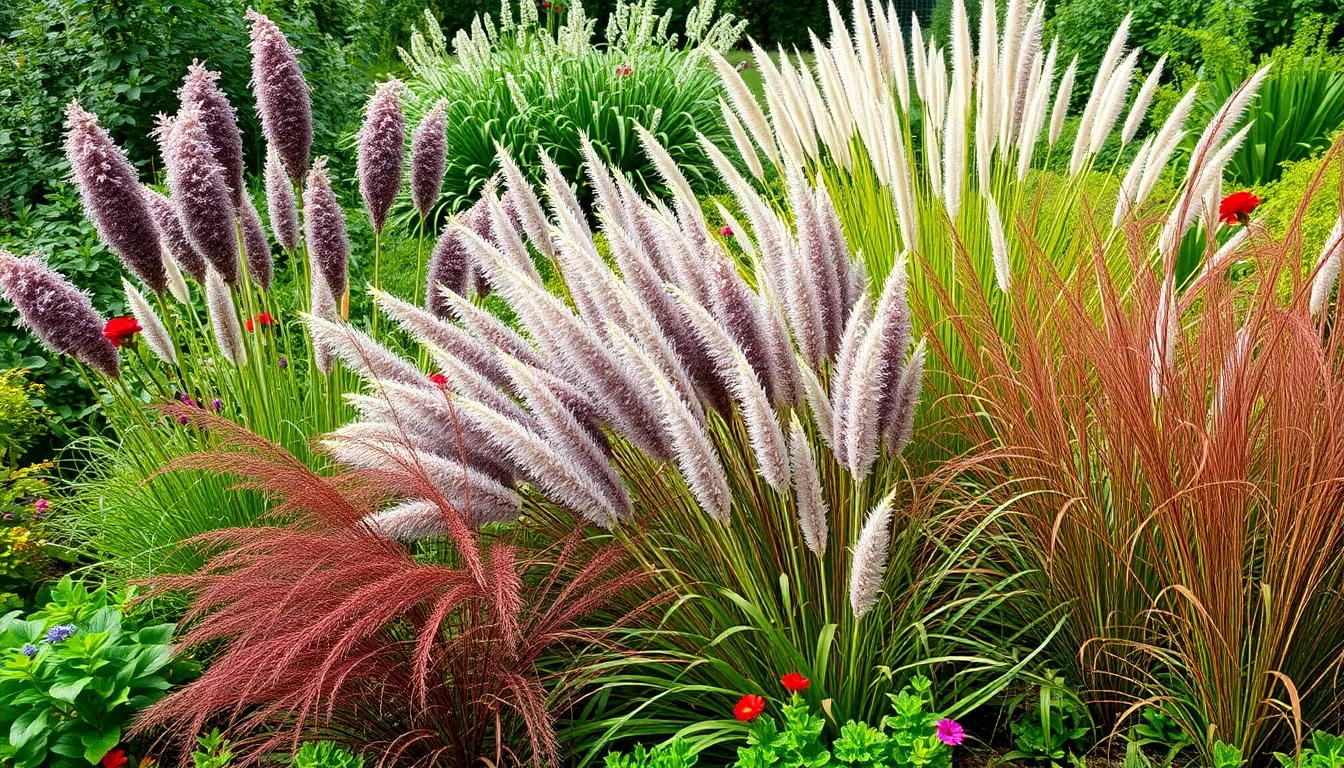
Ornamental grasses transform traditional garden spaces into ever-changing landscapes that offer year-round visual appeal with minimal maintenance requirements. These versatile plants provide texture, movement, and seasonal interest while serving as stunning focal points or complementary elements in your outdoor design.
Select Decorative Grass Species for Visual Impact
Pennisetum (Fountain Grass) creates dramatic focal points with its distinctive plumes that add texture and graceful movement to any garden space. We recommend this species for homeowners seeking bold visual statements that sway beautifully in gentle breezes.
Panicum virgatum (Switchgrass) offers exceptional versatility as a native North American grass species with diverse color variations and textural qualities. This hardy option provides sustainable landscaping answers while supporting local wildlife populations and adapting to various soil conditions.
Schizachyrium scoparium (Little Bluestem) delivers stunning blue-green foliage that transforms into golden hues during fall months. We find this compact grass perfect for creating natural borders or filling smaller garden spaces with seasonal color transitions.
Hakonechloa (Japanese Forest Grass) excels in shaded garden areas where its elegant, cascading growth habit creates soft, flowing textures. This species works exceptionally well under tree canopies or in woodland garden settings where other grasses might struggle.
Arrange Grasses by Height and Texture
Tall grass varieties function as natural privacy screens or commanding statement pieces throughout your industry design. Examples like Pampas Grass and mature Fountain Grass create vertical interest while blocking unwanted views from neighboring properties.
Short grass selections serve as effective groundcover alternatives or textural border elements that define garden pathways and bed edges. We position these compact varieties strategically to create visual transitions between larger plantings.
Textural combinations enhance visual interest by pairing fine, delicate grass species with coarser, more robust varieties. This contrast technique creates depth and prevents monotonous appearances while maintaining cohesive design themes.
Add Seasonal Interest with Flowering Varieties
Summer blooming grasses like Pennisetum produce vibrant plumes during peak growing season, creating spectacular displays that attract beneficial pollinators. We schedule these varieties to provide continuous color when traditional flowering plants might fade in intense heat.
Fall color transformations occur in species like Little Bluestem and Switchgrass, which develop golden or orange tones as temperatures cool. These seasonal changes extend garden interest well beyond typical growing seasons while reducing autumn maintenance needs.
Winter structural elements emerge when we leave ornamental grasses unpruned through cold months, providing essential wildlife shelter and fascinating textural displays. These dried plumes create architectural interest against snow and ice while supporting overwintering beneficial insects.
Build Low-Maintenance Native Grass Landscapes
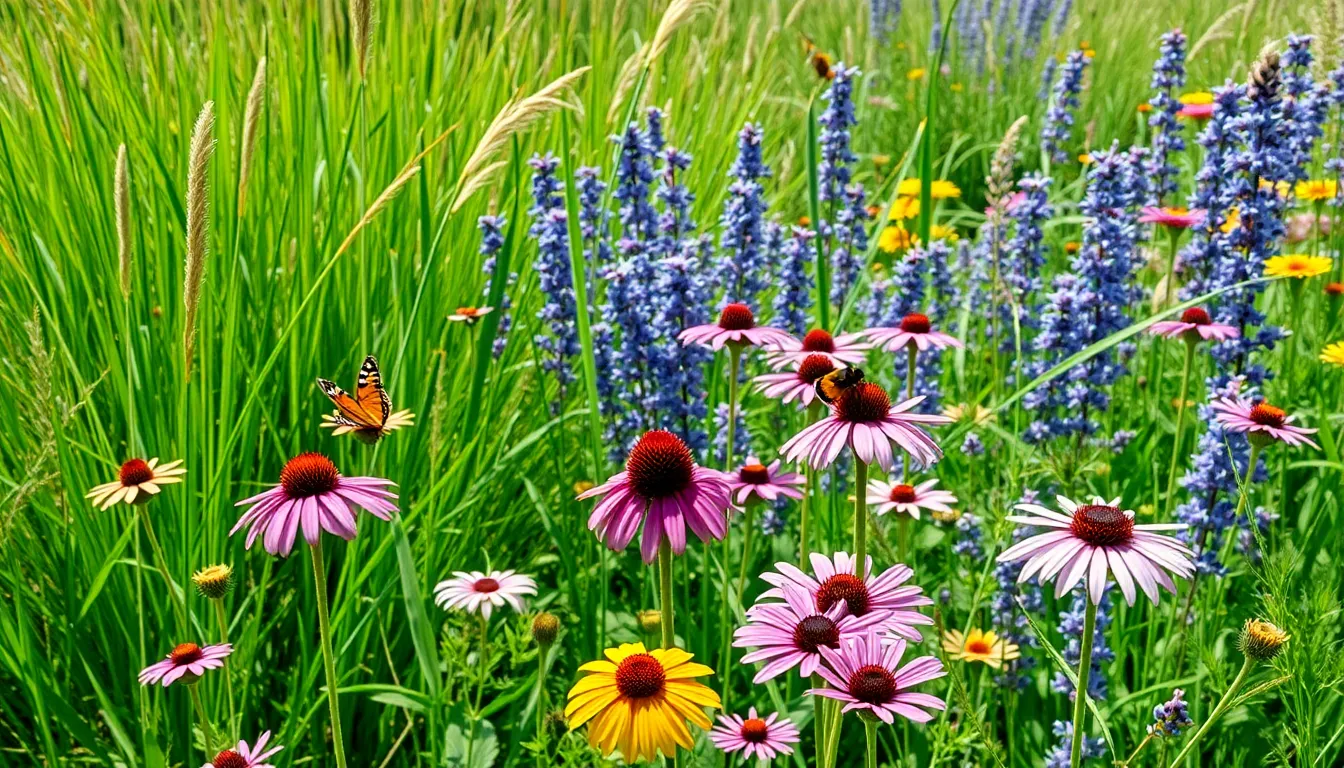
Creating stunning grass gardens doesn’t require endless upkeep when we choose native species that naturally thrive in our local environment.
Research Indigenous Grass Species in Your Region
Local climate adaptation makes native grasses the smartest choice for sustainable landscaping. Native plants naturally resist pests and diseases because they’ve evolved alongside local environmental conditions. We’ll find these species require significantly fewer pesticides and fertilizers compared to non-native alternatives.
Start by contacting your regional extension office or native plant society for species recommendations. They’ll provide detailed lists of grasses that flourish in your exact soil type and rainfall patterns. Research shows that indigenous grasses can reduce maintenance costs by up to 75% once established.
Consider factors like mature height, spreading habits, and seasonal appearance when selecting varieties. Some native grasses like buffalo grass work perfectly for ground cover, while others such as big bluestem create dramatic vertical elements. Document your site’s sun exposure, drainage patterns, and soil pH to match the right species to each location.
Establish Natural Prairie-Style Gardens
Prairie style designs incorporate multiple layers of native grasses and wildflowers for maximum visual impact. We can create diverse habitats that support local wildlife while requiring minimal intervention throughout the growing season. This approach mimics natural grassland ecosystems that once covered much of North America.
Plant taller grasses like switchgrass in the back with shorter varieties such as little bluestem in the foreground. Add native wildflowers like purple coneflower and black-eyed Susan between grass clumps to create seasonal color bursts. This layered structure provides year-round interest as different species bloom and change color throughout the seasons.
Use native grasses as understory plantings beneath existing trees and shrubs. Short species like buffalo grass or blue grama work excellently under tree canopies where traditional lawn grass struggles. We can also incorporate native grasses into rain gardens where they’ll absorb excess water naturally while attracting beneficial insects and birds.
Reduce Water and Fertilizer Requirements
Drought-tolerant native grasses dramatically cut irrigation needs compared to traditional lawn alternatives. Once established, most native species survive on natural rainfall alone, even during dry periods. We’ll see water usage drop by 50-80% when replacing conventional turf with native grass gardens.
Container gardens offer another low-maintenance option for smaller spaces or rental properties. Growing native grasses in large pots or raised beds brings wildlife benefits to patios, balconies, and urban settings. Choose compact varieties like prairie dropseed or sedge species that adapt well to container growing conditions.
Ground cover applications eliminate the need for regular fertilization schedules. Native grasses develop extensive root systems that access nutrients deep in the soil profile. We can expect these plants to thrive without synthetic fertilizers since they’re adapted to local soil conditions and nutrient levels.
Install Grass Pathways and Living Walkways
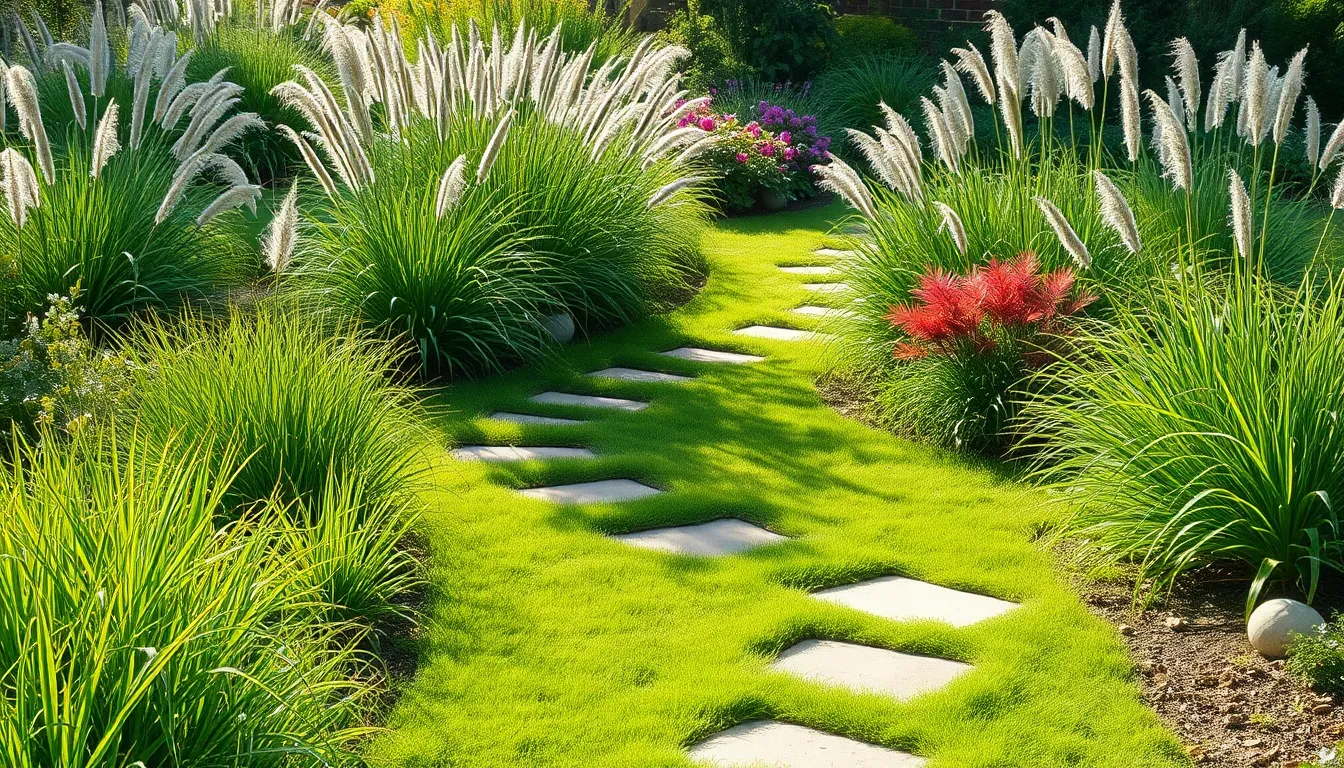
Grass pathways offer an elegant solution for connecting different areas of your garden while maintaining the natural flow of your industry. These living walkways blend seamlessly into existing vegetation and create soft transitions between garden spaces.
Create Meandering Grass Trails Through Gardens
Meandering grass trails add whimsical charm to any garden design while encouraging exploration of your outdoor space. We recommend using a mix of grasses with varying textures and heights to create visual interest along these winding paths. Tall ornamental varieties like fountain grass can frame the trail edges, while shorter selections provide comfortable walking surfaces.
Different sections of your garden become naturally defined when connected by these curved pathways. Strategic placement of these trails allows you to showcase various plantings while creating intimate garden rooms. Visitors feel drawn to explore hidden corners and discover new perspectives as they follow the gentle curves.
Use Durable Grass Types for High Traffic Areas
High traffic pathways require resilient grass varieties that can withstand constant foot traffic without losing their appeal. Buffalo grass stands out as an excellent choice for these demanding areas due to its exceptional durability and drought tolerance. Blue grama grass offers another robust option that maintains its structure even under heavy use.
These hardy varieties require significantly less maintenance compared to traditional lawn grasses while providing reliable performance. Establishment takes minimal effort, and once mature, these grasses thrive with little intervention. Root systems develop deep networks that resist compaction and recover quickly from wear.
Design Stepping Stone and Grass Combinations
Stepping stone pathways combined with grass create visually striking walkways that balance functionality with natural beauty. We place stones at comfortable intervals to allow grass to grow freely around each element, creating a harmonious blend of textures. This approach provides sure footing while maintaining the soft, organic feel of a grass pathway.
Natural stone materials complement the surrounding vegetation and age gracefully over time. Grass fills the spaces between stones, softening hard edges and creating a unified design. Maintenance becomes simplified as the grass naturally defines the pathway boundaries while the stones handle the heaviest foot traffic.
Construct Terraced Grass Garden Levels
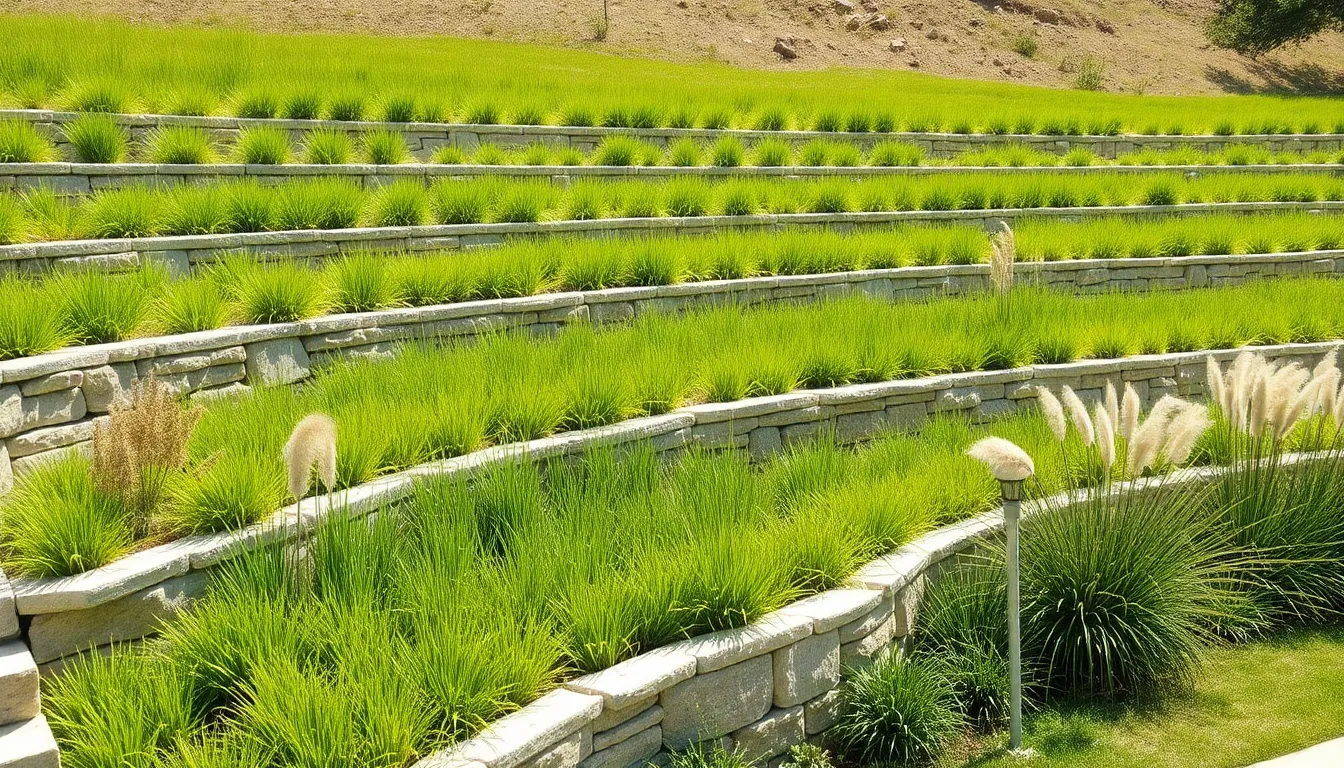
Terraced grass gardens transform challenging slopes into functional outdoor spaces with stunning visual appeal. We’ll guide you through creating stable, attractive levels that maximize your sloped property’s potential.
Build Retaining Walls for Sloped Areas
Assess your slope’s steepness and length to determine how many terraces you’ll need for optimal stability. Wood, stone, and concrete blocks serve as excellent materials for constructing durable retaining walls that withstand weather and time.
Level installation becomes critical for preventing water accumulation and dangerous erosion that can undermine your entire terraced system. Stone retaining walls offer natural beauty while providing the structural integrity needed for steep gradients.
Design considerations should include both functionality and aesthetics to create walls that enhance rather than dominate your industry. Decorative elements like integrated planters, natural stone textures, or cascading water features transform practical retaining structures into stunning garden focal points.
Different activities require varying terrace dimensions, so we recommend creating larger levels for dining areas and smaller tiers for ornamental displays. Concrete provides durability for high use areas while natural materials like fieldstone complement traditional garden designs.
Plant Different Grass Types on Each Tier
Sunlight exposure varies significantly between upper and lower terraced levels, making grass selection crucial for long term success. Shade tolerant varieties like fine fescue thrive on lower tiers where tree canopies or upper levels block direct sunlight.
Drought resistant grasses perform best on higher terraces where water naturally drains away and sun exposure intensifies throughout the day. Buffalo grass and blue grama grass establish strong root systems that prevent erosion while requiring minimal irrigation.
Texture combinations create visual interest when we plant different grass types across multiple tiers, from fine textured bent grass to coarser tall fescue varieties. Ornamental grasses like fountain grass and switchgrass add seasonal color transitions and movement that complement traditional turf areas.
Water requirements differ dramatically between grass species, allowing us to group plants with similar needs on the same terrace level. This strategic placement reduces maintenance while ensuring each variety receives appropriate moisture and care.
Incorporate Drainage Answers for Stability
French drains installed at each tier’s base prevent dangerous water accumulation that can cause retaining wall failure and soil erosion. These underground drainage systems channel excess water away from terraced areas before saturation occurs.
Soil grading should slope slightly toward retaining walls to help natural water runoff and prevent standing water on planted surfaces. This gentle grade promotes healthy root development while maintaining the aesthetic appeal of level terraced areas.
Swales create sustainable water management by collecting and filtering rainwater naturally between terraced levels. These shallow ditches reduce runoff velocity while allowing beneficial water infiltration into surrounding soil.
Proper drainage prevents costly repairs and maintains the structural integrity that makes terraced grass gardens both beautiful and functional for years to come. Strategic placement of drainage answers ensures your investment remains stable through seasonal weather changes and heavy precipitation events.
Develop Zen-Inspired Grass Meditation Spaces
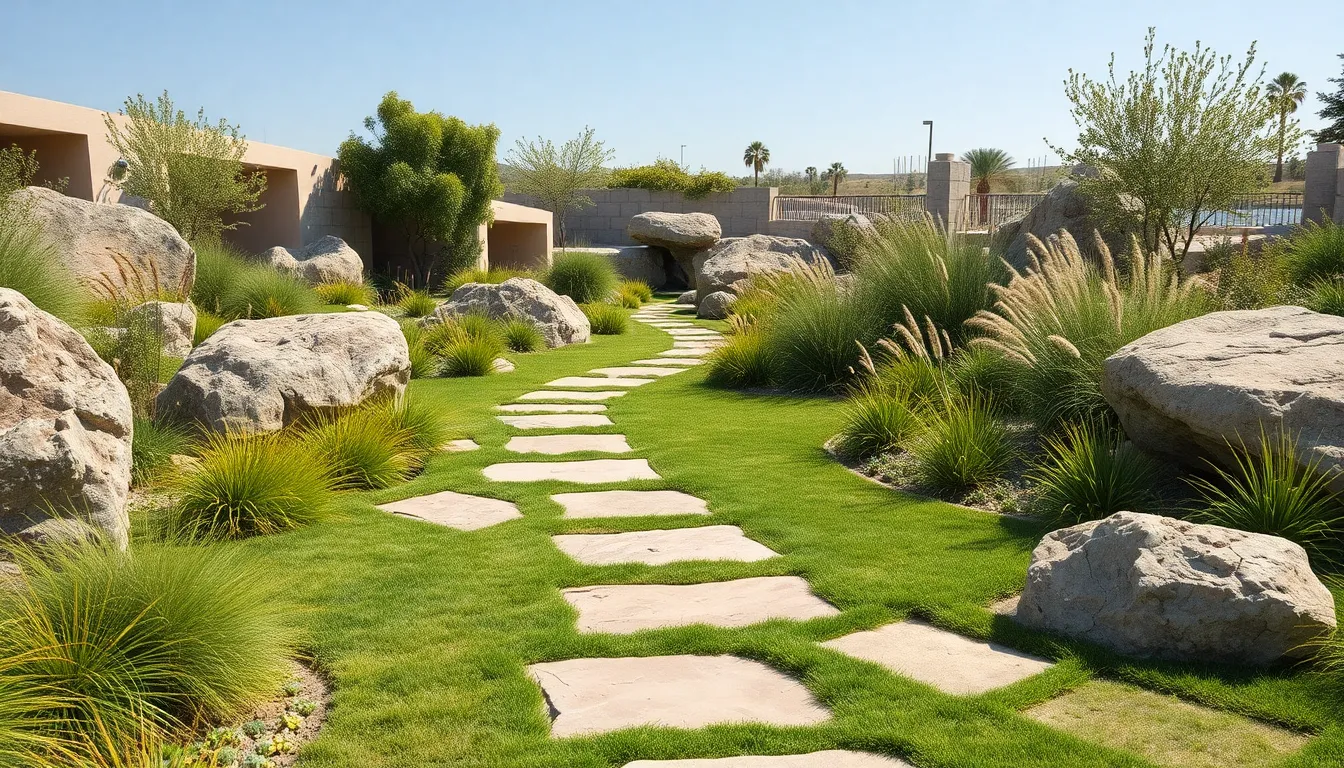
Creating a peaceful sanctuary doesn’t require extensive landscaping when we focus on the meditative qualities of grass gardens. These tranquil spaces invite contemplation while maintaining the natural beauty we’ve been cultivating throughout our outdoor areas.
Create Simple Geometric Grass Patterns
Dividing our garden into distinct sections helps establish a sense of order that promotes mindfulness and relaxation. We can use natural pathways like stone pavers or wooden walkways to separate different grass areas, creating a meditative route through our space.
Grouping grasses in thoughtful arrangements allows us to develop visual interest without overwhelming the senses. Asymmetrical patterns work best for Zen-inspired designs, as they follow nature’s irregular beauty while encouraging the eye to move gently across the industry.
Selecting drought-tolerant grass varieties ensures our meditation space remains peaceful without demanding constant attention. Low maintenance grasses like buffalo grass or blue grama grass thrive with minimal care, letting us focus on enjoying the space rather than maintaining it.
Add Contemplative Elements Like Stone Features
Incorporating large rocks or boulders creates natural anchor points that complement the flowing movement of ornamental grasses. These stone features provide visual weight and stability, balancing the soft textures of grass with solid, grounding elements.
Integrating rock and sand areas between grass sections enhances the meditative quality of our garden design. Sand or small gravel paths allow for contemplative walking while providing textural contrast to the surrounding grass plantings.
Adding water features can enhance the serene atmosphere, though traditional Zen gardens typically focus on dry elements. Small ponds or gentle water fountains create soothing sounds that mask urban noise and encourage deeper relaxation during meditation sessions.
Maintain Minimalist Design Principles
Ensuring adequate negative space between grass plantings prevents our meditation area from feeling cluttered or overwhelming. Open areas allow the mind to rest and create breathing room that’s essential for contemplative garden design.
Following asymmetrical balance principles helps us achieve the natural harmony characteristic of Zen aesthetics. We arrange grass groupings and stone features in irregular patterns that feel organic rather than forced or overly structured.
Limiting our plant palette to just a few grass varieties maintains the simplicity that makes meditation spaces effective. Three to five different grass types provide enough variety for visual interest while keeping the overall design cohesive and calming.
Establish Children’s Play Areas with Soft Grasses
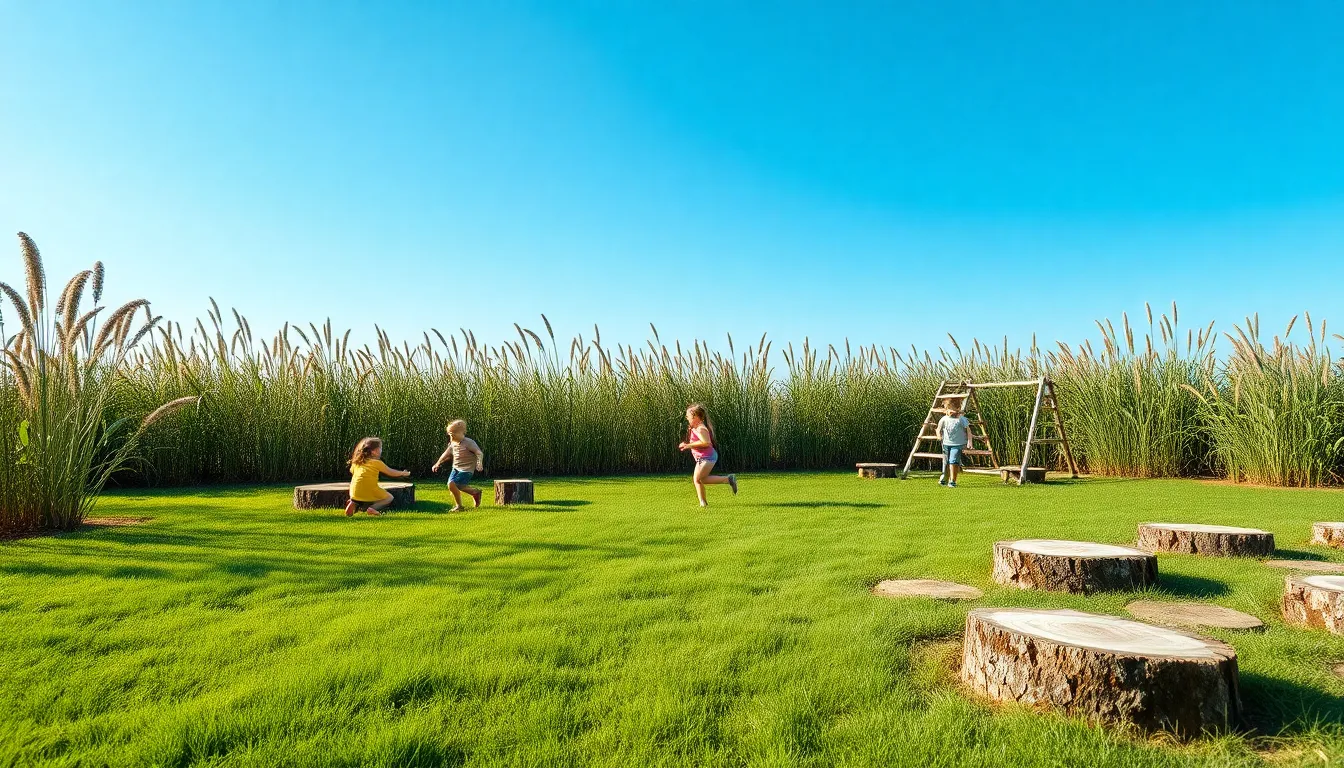
Creating dedicated play spaces within our grass gardens requires careful planning to ensure both safety and durability. We can transform ordinary lawn areas into captivating environments where children can explore and play freely.
Choose Child-Safe and Durable Grass Varieties
Soft grass varieties provide the foundation for safe children’s play areas. Kentucky bluegrass offers exceptional comfort underfoot while maintaining its lush appearance throughout the growing season. Perennial ryegrass varieties deliver similar softness with added resilience against heavy foot traffic from active children.
Artificial grass alternatives present excellent low-maintenance answers for busy families. These synthetic surfaces provide consistent smoothness ideal for active play while eliminating concerns about mud, allergens, or uneven growth patterns. We can incorporate artificial turf into creative DIY projects like mini golf courses that entertain children while requiring minimal upkeep.
Durability considerations become crucial when selecting grass for high-impact play zones. Artificial grass withstands heavy use better than most natural varieties, making it particularly valuable for areas designated for sports activities or frequent gatherings. Natural grass options like tall fescue blends offer robust growth patterns that recover quickly from play-related damage.
Design Open Spaces for Active Play
Large open areas serve as the cornerstone of effective children’s play spaces within grass gardens. We recommend designating substantial sections specifically for running games and sports activities that require unobstructed movement. Artificial turf excels in these applications due to its superior durability and minimal maintenance requirements.
Natural play trails enhance exploration opportunities using low-to-ground features throughout the grass garden. Balance beams crafted from reclaimed wood or strategically placed tree stumps create captivating pathways that encourage active discovery. These elements integrate seamlessly with surrounding grass areas while providing structured play opportunities.
Obstacle courses incorporate existing industry features to maximize engagement without extensive installation. Logs, stumps, and stepping stones transform ordinary grass spaces into adventure zones that challenge children’s coordination and creativity. We can arrange these natural elements to create varying difficulty levels suitable for different age groups.
Create Natural Boundaries with Taller Grasses
Native plantings establish gentle boundaries that blend naturally with surrounding landscapes. Taller grass species and indigenous plants create defined zones without harsh visual barriers that might feel restrictive to children. These natural borders maintain the organic flow of our grass garden design while providing clear spatial organization.
Visual separation techniques use ornamental grasses to define different activity areas within larger play spaces. Strategic placement of taller varieties creates intimate zones for quieter activities while maintaining sight lines for supervision. We can select grasses with varying heights and textures to add visual interest while serving practical boundary functions.
Safety considerations guide our selection of boundary grasses to ensure child-friendly environments. Smooth-edged varieties without sharp seed heads or thorny characteristics protect children during active play. Native species typically require less chemical treatment, reducing exposure to potentially harmful substances in areas where children spend important time.
Integrate Grass Gardens with Water Features
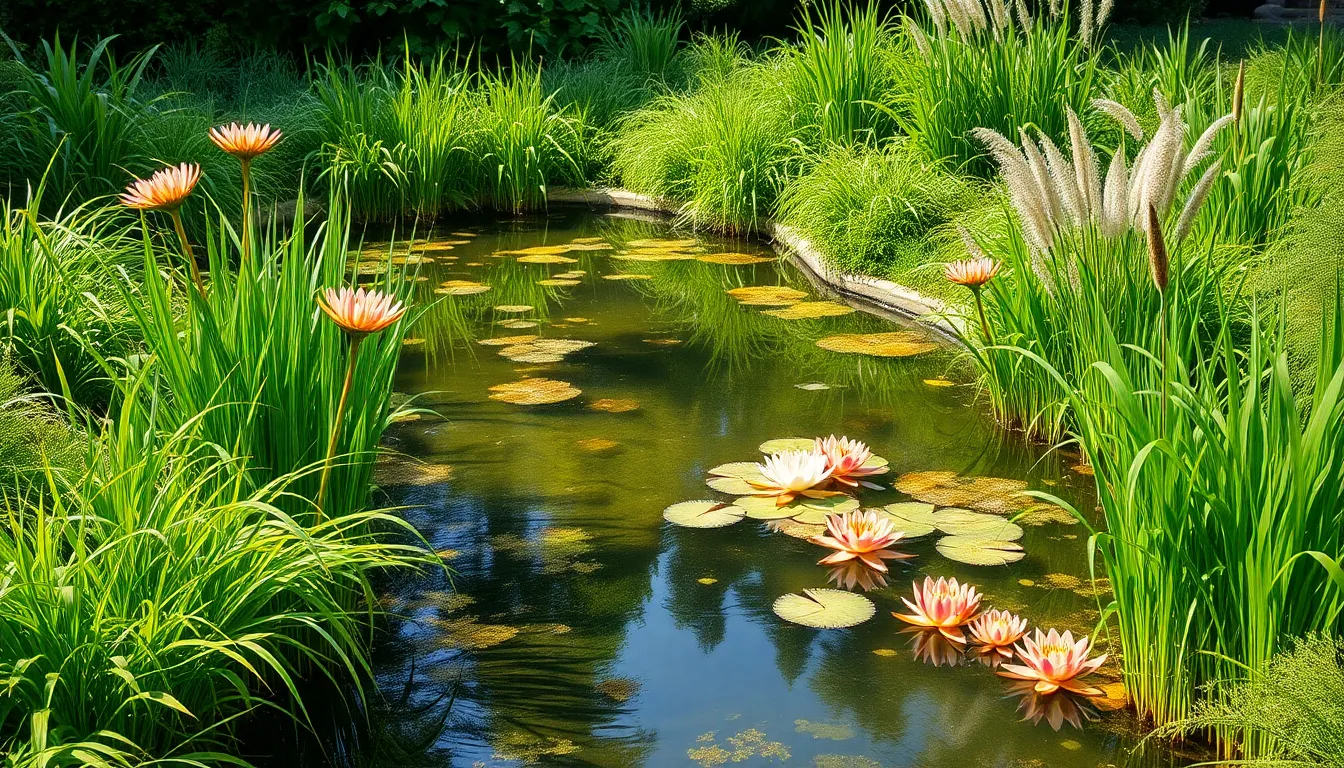
Water features transform ordinary grass gardens into ever-changing landscapes that engage multiple senses while providing ecological benefits. Combining ornamental grasses with ponds, streams, and water gardens creates natural transitions between aquatic and terrestrial elements.
Surround Ponds with Moisture-Loving Grasses
Moisture loving grasses thrive in pond margins where they stabilize soil and filter water runoff naturally. Carex species, commonly known as sedges, establish dense root systems that prevent erosion along water edges. Pennisetum fountain grasses add dramatic texture with their cascading plumes that dance in breezes above the water surface. Miscanthus varieties provide towering backgrounds that create privacy screens while supporting beneficial wildlife.
Planting these grasses in clusters creates naturalistic drifts that soften harsh pond edges. We recommend spacing plants 18 to 24 inches apart to allow for mature spread while maintaining defined groupings. Strategic placement prevents soil erosion during heavy rains when runoff flows toward the water feature. Wildlife benefits include nesting sites for birds and shelter for beneficial insects that help control garden pests.
Create Stream Side Grass Plantings
Stream side plantings blend water features seamlessly into surrounding landscapes through layered grass arrangements. Taller ornamental grasses like Miscanthus create dramatic backdrops that provide structure and seasonal interest throughout the year. Medium height varieties such as Pennisetum establish middle layers that bridge the transition between tall background grasses and water level plantings.
Lower growing species near water edges require minimal maintenance while improving the sensory garden experience. Carex sedges tolerate wet feet and spread naturally to create dense groundcover along stream banks. Movement from flowing water combines with grass motion to create soothing sounds and visual rhythm. We suggest mixing different textures and heights to maximize visual interest while ensuring easy access for routine maintenance tasks.
Design Grass Islands in Water Gardens
Grass islands add structural dimension to large water features while creating focal points that break up open water expanses. These raised planting areas require hardy, moisture tolerant grasses that withstand fluctuating water levels and seasonal changes. Small islands work best in ponds larger than 8 feet across where they won’t overwhelm the water surface.
Strategic island placement provides habitat for beneficial insects while supporting garden network health. We recommend using native grass species that require minimal fertilization and naturally resist common water garden pests. Contrasting grass textures create visual interest when combined with water lilies and marginal aquatic plants. Proper drainage within islands prevents waterlogged soil conditions that can damage grass root systems during extended wet periods.
| Grass Type | Water Tolerance | Mature Height | Best Placement |
|---|---|---|---|
| Carex species | High | 12-36 inches | Pond margins, stream edges |
| Pennisetum | Moderate to High | 24-48 inches | Pond surrounds, island centers |
| Miscanthus | Moderate | 48-96 inches | Background, privacy screens |
Plant Seasonal Grass Display Gardens
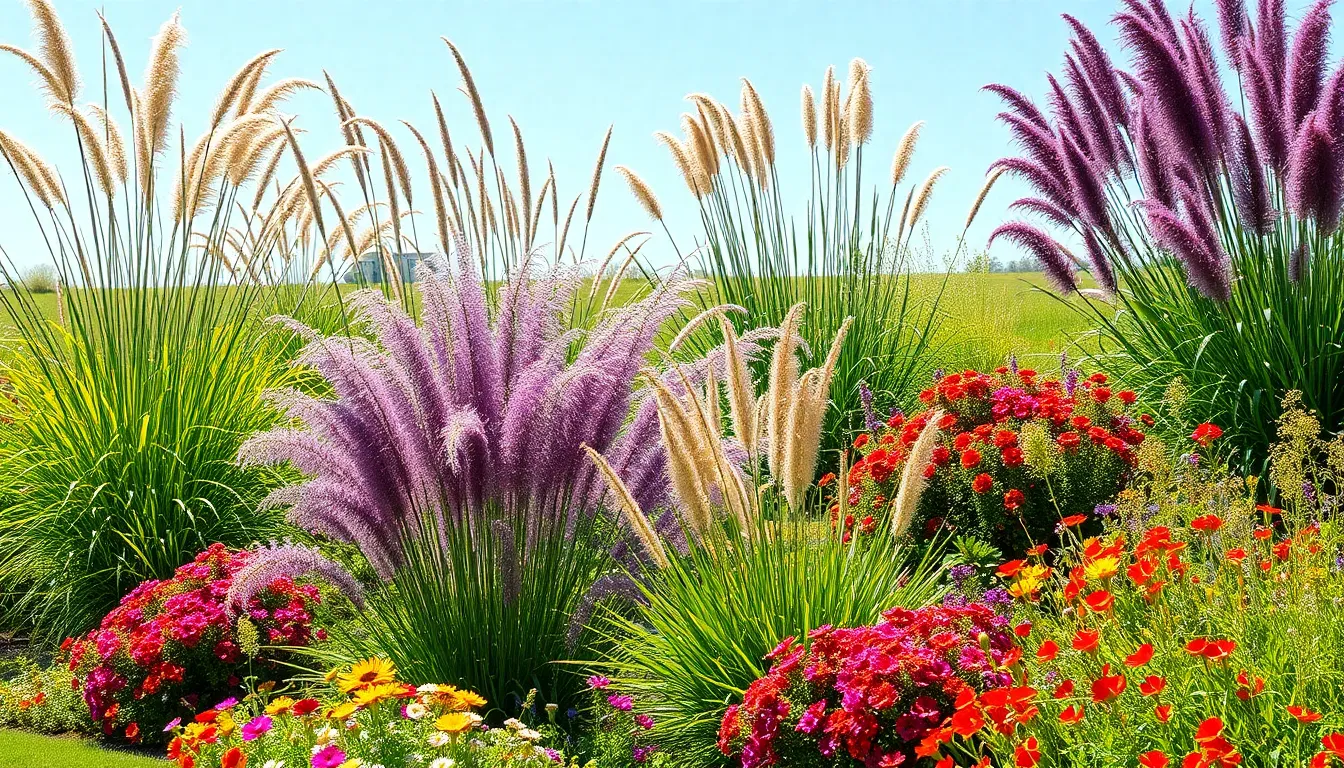
Moving beyond static landscapes, we can create ever-changing gardens that transform throughout the year by strategically selecting grasses that peak at different seasons. This approach ensures our outdoor spaces remain visually compelling from spring through winter.
Plan for Year-Round Color and Texture Changes
Layering plants creates the foundation for continuous visual interest in our grass gardens. We combine ornamental grasses with complementary flowers and shrubs to establish a ever-changing industry that evolves through each season.
Seasonal planting requires mixing early, mid-season, and late bloomers to maintain constant appeal. Spring emerges with fresh green growth, summer brings lush foliage and flowering plumes, while autumn delivers spectacular color transformations.
Texture variety comes from incorporating different heights and forms throughout our design. Tall varieties like Miscanthus sinensis serve as dramatic backdrops, while shorter selections create flowing groundcover that connects garden elements seamlessly.
Combine Cool and Warm Season Varieties
Cool season grasses like Festuca and Liriope grow actively during spring and fall months. These varieties provide early spring interest when most plants remain dormant, often staying green through winter to maintain garden structure.
Warm season grasses including Pennisetum and Schizachyrium scoparium (Little Bluestem) thrive during summer and fall periods. They offer vibrant colors and distinctive textures during warmer months when cool season varieties enter dormancy.
Strategic placement of both types ensures our gardens never lack visual appeal. We position cool season varieties where early spring color matters most, while warm season grasses anchor areas that need summer and fall drama.
Create Dramatic Autumn Grass Showcases
Grass and plant combinations pair ornamental varieties with fall-blooming perennials like asters and sedum for spectacular autumn displays. Pennisetum alopecuroides and Miscanthus sinensis deliver stunning fall colors while maintaining attractive winter textures that extend seasonal interest.
Lighting enhances evening garden beauty during autumn months. Solar-powered fixtures highlight grass plumes and surrounding foliage, creating magical displays that showcase the season’s transformation after dark.
Color coordination maximizes autumn impact through thoughtful plant selection. We choose grasses that complement fall perennials, creating cohesive color schemes that celebrate the season’s natural palette.
Conclusion
We’ve explored countless ways to transform your outdoor space with grass garden ideas that deliver stunning results without overwhelming maintenance demands. From classic English lawns to prairie-style landscapes each approach offers unique benefits for different lifestyles and climates.
The beauty of grass gardening lies in its versatility. Whether you’re working with challenging slopes terraced gardens or small urban containers there’s a solution that fits your space and vision. Native species provide sustainable options while ornamental varieties add year-round visual drama.
Remember that successful grass gardens start with understanding your local environment and choosing varieties that thrive naturally in your conditions. With proper planning and the right grass selections you’ll create an outdoor sanctuary that enhances your property value while providing years of enjoyment with minimal upkeep.
Frequently Asked Questions
What are the best grass types for different climates?
For northern regions, choose cool-season grasses like Kentucky bluegrass and perennial ryegrass. Southern climates benefit from warm-season varieties such as Zoysia grass. These selections ensure your lawn thrives in local conditions while requiring less maintenance and water.
How can I create a low-maintenance lawn?
Focus on native grass species that naturally thrive in your area. Native grasses require minimal watering, fertilizing, and pest control. Consider ornamental grasses like fountain grass or switchgrass, which provide year-round visual appeal with virtually no upkeep required.
What ornamental grasses work best for landscaping?
Pennisetum (Fountain Grass) creates bold focal points, Panicum virgatum (Switchgrass) offers versatility and wildlife support, and Little Bluestem provides stunning seasonal color changes. Arrange by height with tall varieties as screens and shorter ones as groundcover.
How do I design grass pathways in my garden?
Create meandering trails using durable grasses like buffalo grass or blue grama for high-traffic areas. Combine stepping stones with grass sections for visual interest. Design natural curves that encourage exploration while connecting different garden areas seamlessly.
Can I grow grass gardens in small spaces?
Yes! Container gardens work perfectly for urban settings and small yards. Use native grasses in large pots or planters to create portable, low-maintenance displays. This approach allows flexibility in design while bringing natural beauty to confined spaces.
How do I maintain terraced grass gardens on slopes?
Build proper retaining walls with adequate drainage using French drains or swales. Select appropriate grass types for each level based on sun exposure – shade-tolerant varieties below, drought-resistant grasses above. Ensure level terraces to prevent erosion.
What makes a good children’s play area with grass?
Choose soft, resilient grasses like Kentucky bluegrass or perennial ryegrass for safety and comfort. Create open spaces for active play while using taller native grasses as natural boundaries. Consider artificial grass for high-traffic zones requiring zero maintenance.
How do I incorporate water features with grass gardens?
Plant moisture-loving grasses like Carex species around pond edges for soil stabilization and natural filtration. Create layered grass plantings along streams and design grass islands in water gardens to add structural dimension and beneficial insect habitat.
When should I plant different grass varieties for year-round appeal?
Mix cool and warm-season grasses for continuous interest. Plant early bloomers in spring, mid-season varieties for summer color, and late bloomers for fall displays. Combine ornamental grasses with fall perennials for dramatic autumn showcases with extended visual impact.






